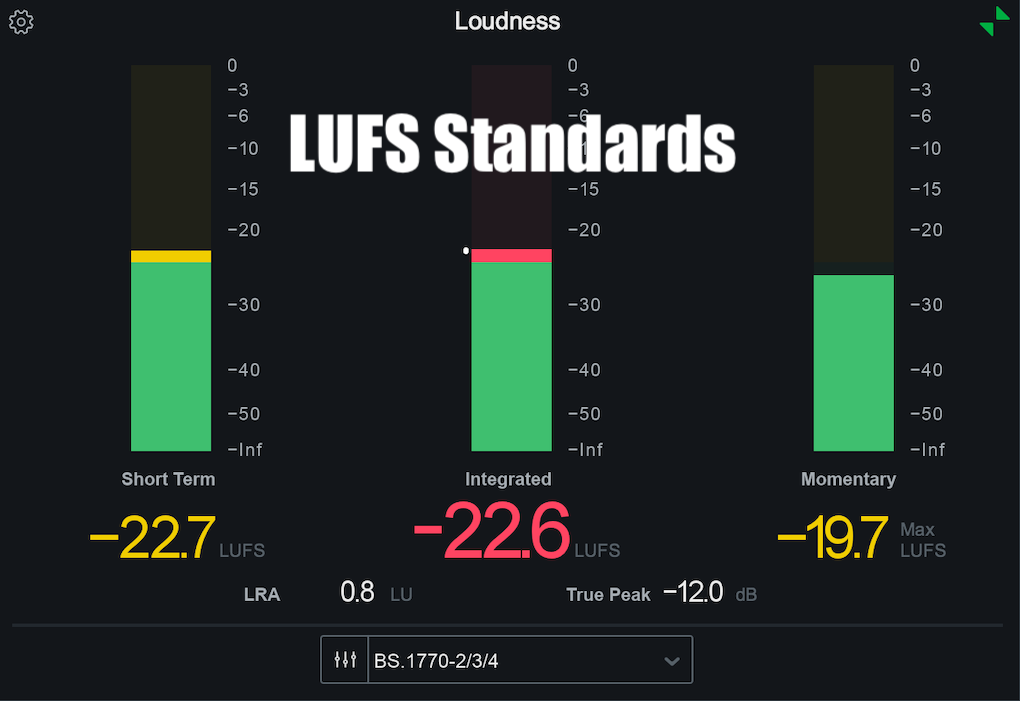- in Production by Bobby Owsinski
The Standard LUFS Standards Levels Every Mixer Should Know

Looking back at the analog days, mixing level requirements seemed so easy. You aimed for 0 on the VU meter and didn’t worry too much if it bounced over. Of course, under the hood 0VU could actually be calibrated to different levels, but we usually didn’t concern ourselves too much with that as long as it was clean around the 0 mark. These days there are so many different meter reference calibrations available that it can take some time to settle on one that you feel comfortable with. That said, LUFS looms large when it comes to delivery signal levels, and that makes for lots of confusion.
A Little LUFS Background
Most audio metering looks at what’s happening right now, while while LUFS can do that with its Short Term setting, the Long Term or Integrated setting that’s most often used looks at a more or less average level of the entire program, plus adds in a smart algorithm that matches to how we hear. It was created primarily as way to level out the differences between the audio level of a television program and the commercials shown in between the program segments.
Back before LUFS, commercials were heavily compressed so they’d be a lot louder than the TV program, even though the actual meter levels were the same. So many viewers complained over the years that something had to be done, and LUFS was born in the US and LKFS (same thing, different term) in Europe.
This actually worked so well in television that other parts of the audio industry adopted it as well, and that’s where the confusion sets in. There are a lot of different standards, and that can mean confusion for the average music mixer. Let’s try to sort this out with some standards.
The Known Standards
-24LUFS – This is your target if you’re mixing for television (-23LKFS in the rest of the world). Out of all the standards, this one is the most serious in that a television network can get its broadcast license revoked for a violation. Send in a program with a higher level, and it will be kicked back for a revision.
-16LUFS for gaming. This isn’t a hard and fast rule, but it’s what the gaming development community has settled on. Nothing serious will happen if you violate this level (you won’t lose your game developers license) so it’s okay if it’s a little off.
-16LUFS for podcasts. Since Apple iTunes has been the principle delivery system for podcasts since the beginning, this is the level it settled on and the rest of the industry followed. It’s usually not a big deal if it’s off a little.
-.1dBFS for music. Yep, you read it correctly. There is no standard LUFS level for music. Just like always, you make it as loud as you need to stay competitive as if you were making a CD.
Music Is Different
“But Apple Music’s standard is at -16LUFS and Spotify is at -14 and YouTube is at -14 and my favorite mastering plugin says -9!”, you’re probably saying right now.
Here’s the thing, no matter what level the master for your song is at, Apple, Spotify, Tidal, Deezer and every other streaming service will normalize it to the standard of the service anyway. You’re just making more unnecessary work for yourself as a mixer by mixing to different levels for different streaming services.
Here what’s important though. Since everything is going to be normalized to the same level anyway, there’s no reason to crush the mix to make it sound louder like in the old days. In fact, the more dynamic range, the better it will sound – except if your song is going to radio or CD. You’re still going to be played up against some pretty loud songs so it’s best to measure up.
Let’s put it like this – A-list mixers and mastering engineers don’t worry about LUFS levels, so why should you? They make it sound as good as they can the same way they’ve always done (maybe not smashing it as hard though). The streaming services will do their thing and put it at their designated level, but it’s not something that you have to worry about.
Many music mixers have started using -9 LUFS as a level to shoot for, mostly because it still allows for some reasonable dynamic range while playing fairly loudly. As you get closer to 0, the dynamic range shrinks considerably, although this can be desirable for electronic or pop music, with most songs from those genres coming in at around -6 LUFS.
On the other hand, acoustic music benefits greatly from a higher LUFS level of -12 to -14 LUFS. If you monitor hits from 70s and 80s, you’ll find that most tend to fall into this range (or even lower), hence the greater dynamic range. Of course, this was a time way before automatically placing a compressor on your mix buss was the norm like it is today.
You still might want to break out that LUFS meter and find a level that you’re comfortable mixing at, but at this point, a dynamic range meter is a better friend.
People also ask:
It depends upon the delivery requirements of your distributor. The standard level varies for television, games, prodcasts and music.
This is apples and oranges. LUFS is a loudness measurement designed to monitor the entire length of the program. Decibels can apply to electronic signal levels or sound pressure levels.
That really depends upon the delivery requirements of the medium you’re working in. Television, gaming, podcasts, and music all have different standard levels. It’s best to consult your distributor for their desired delivery specs.
More compression and/or limiting will boost your LUFS level. This should be done with caution as higher compression can also introduce audio artifacts that are undesirable.
